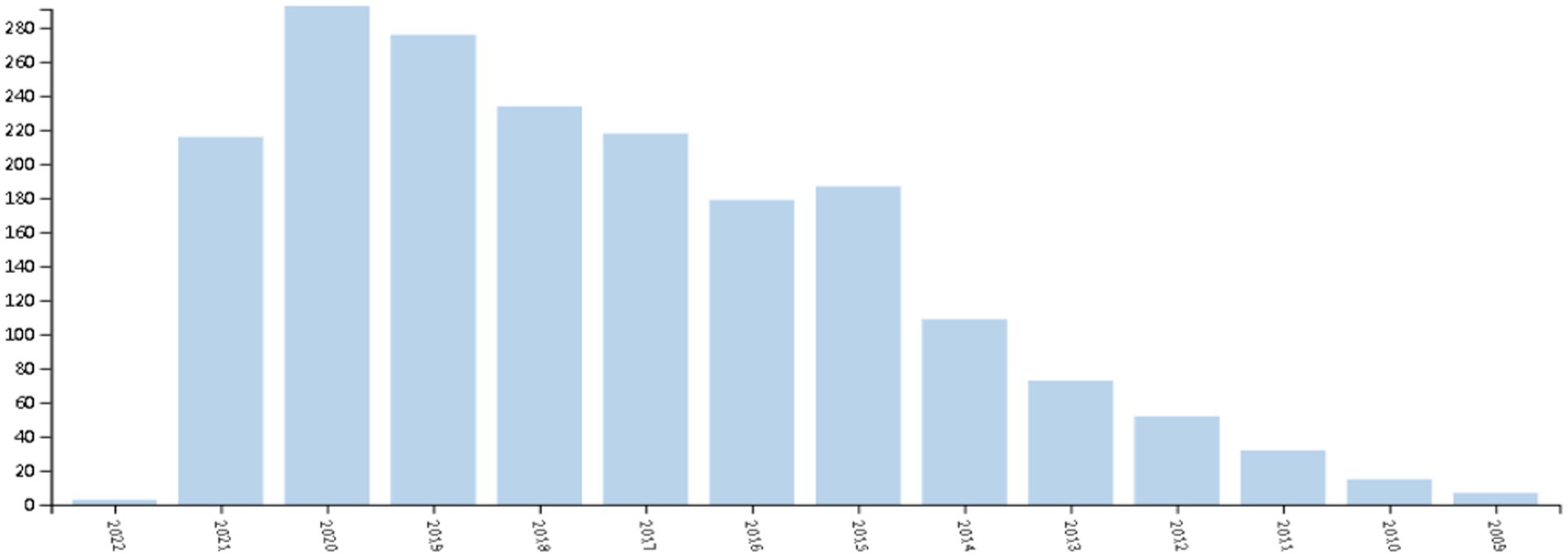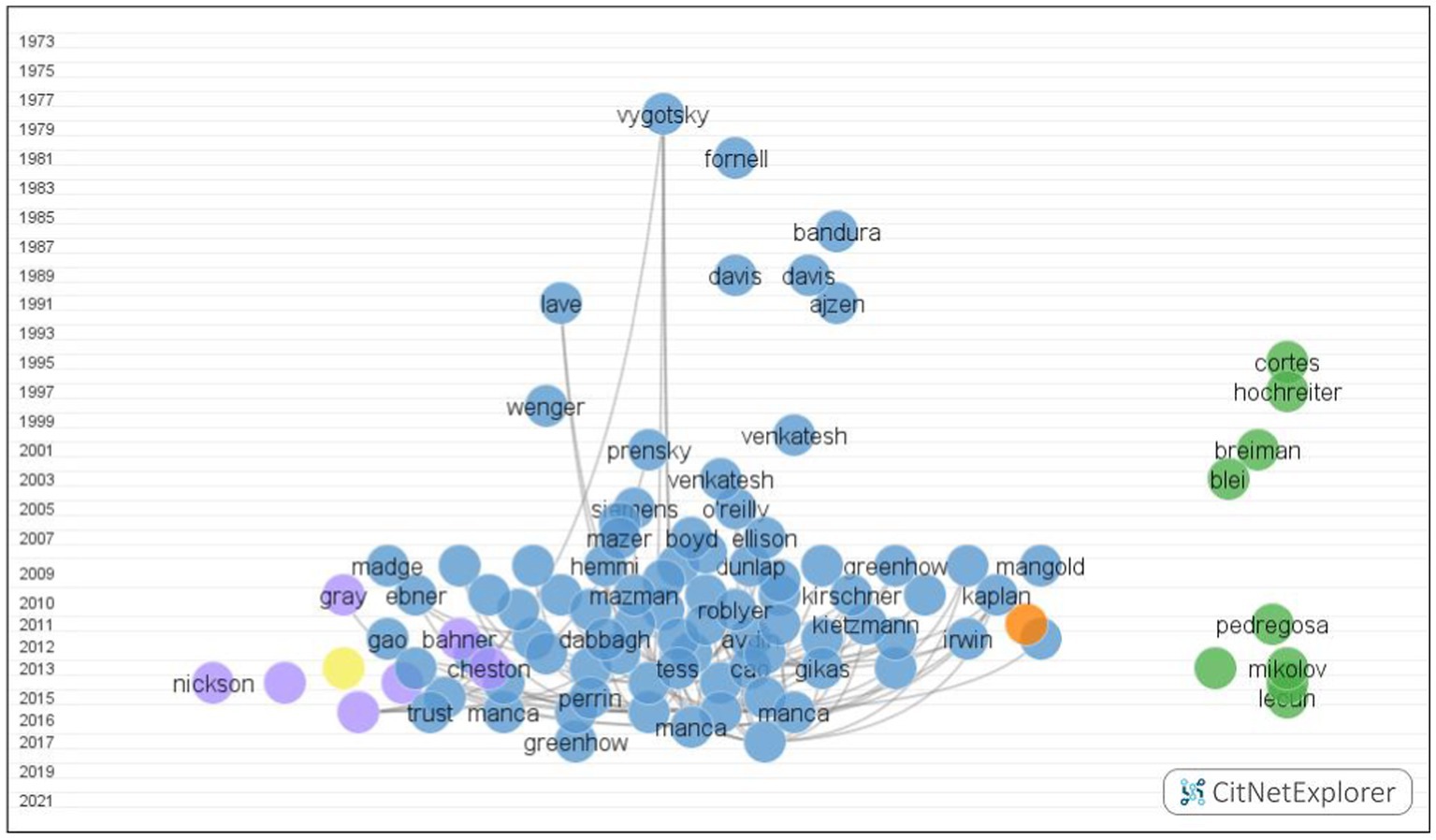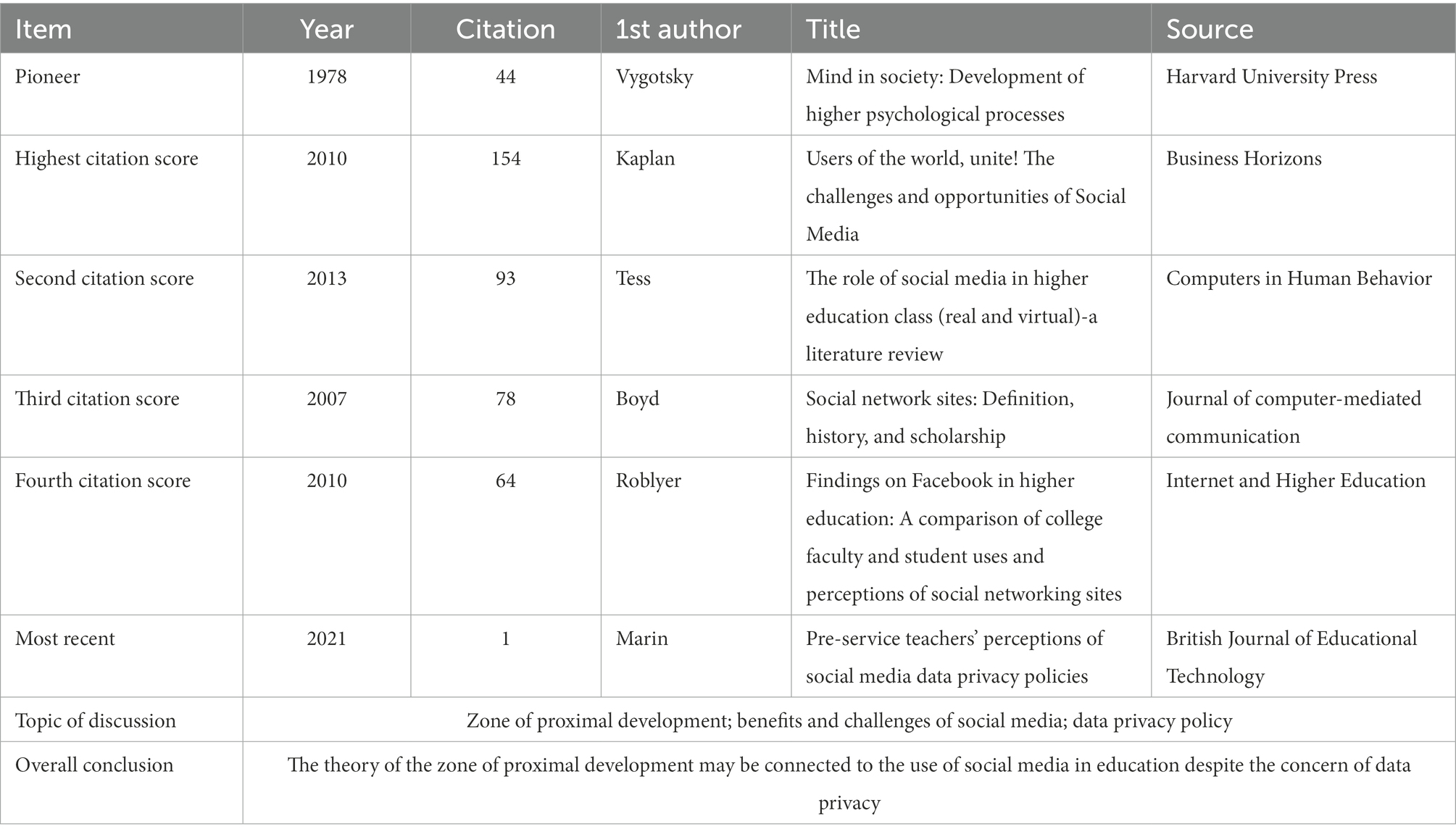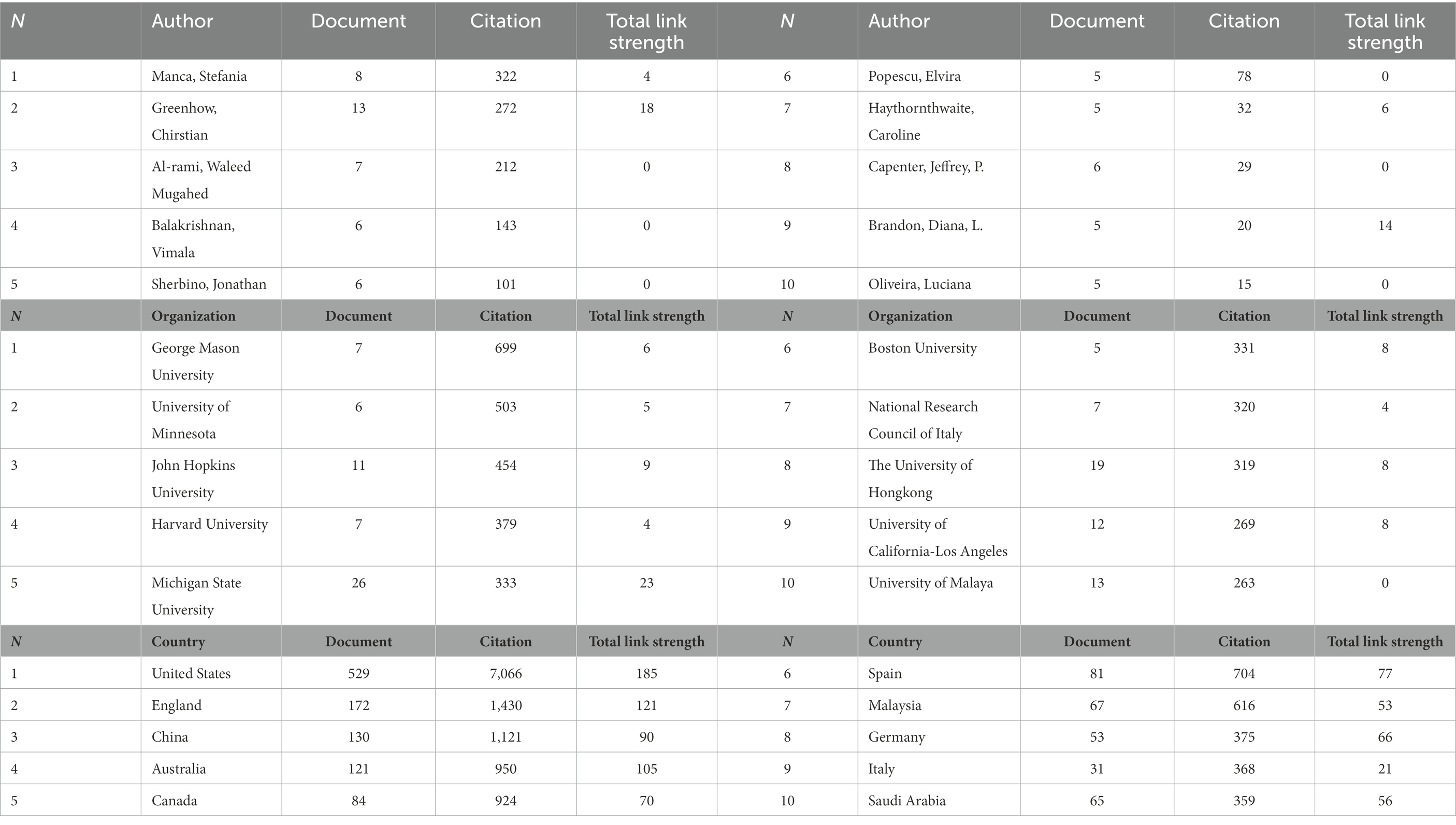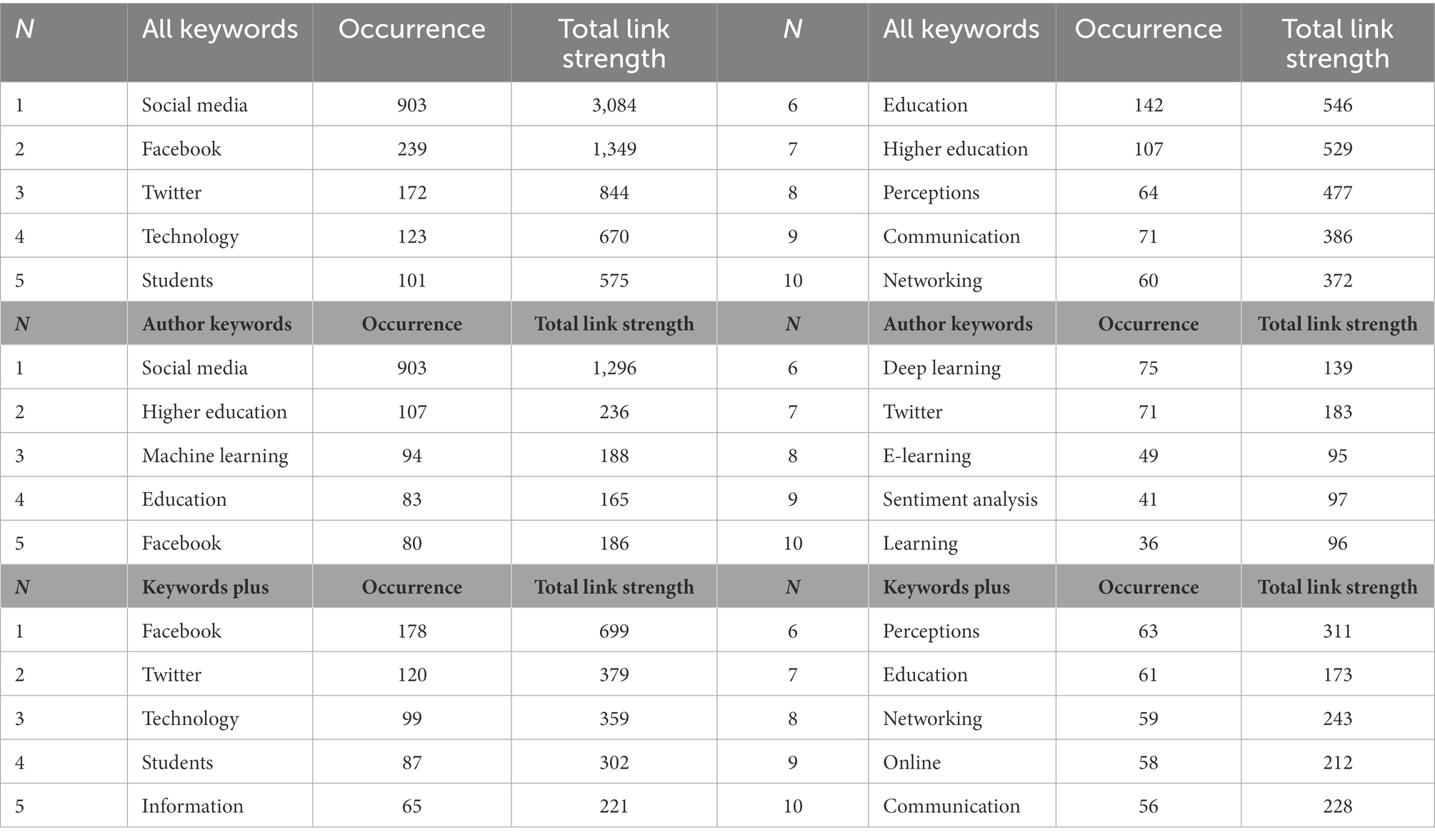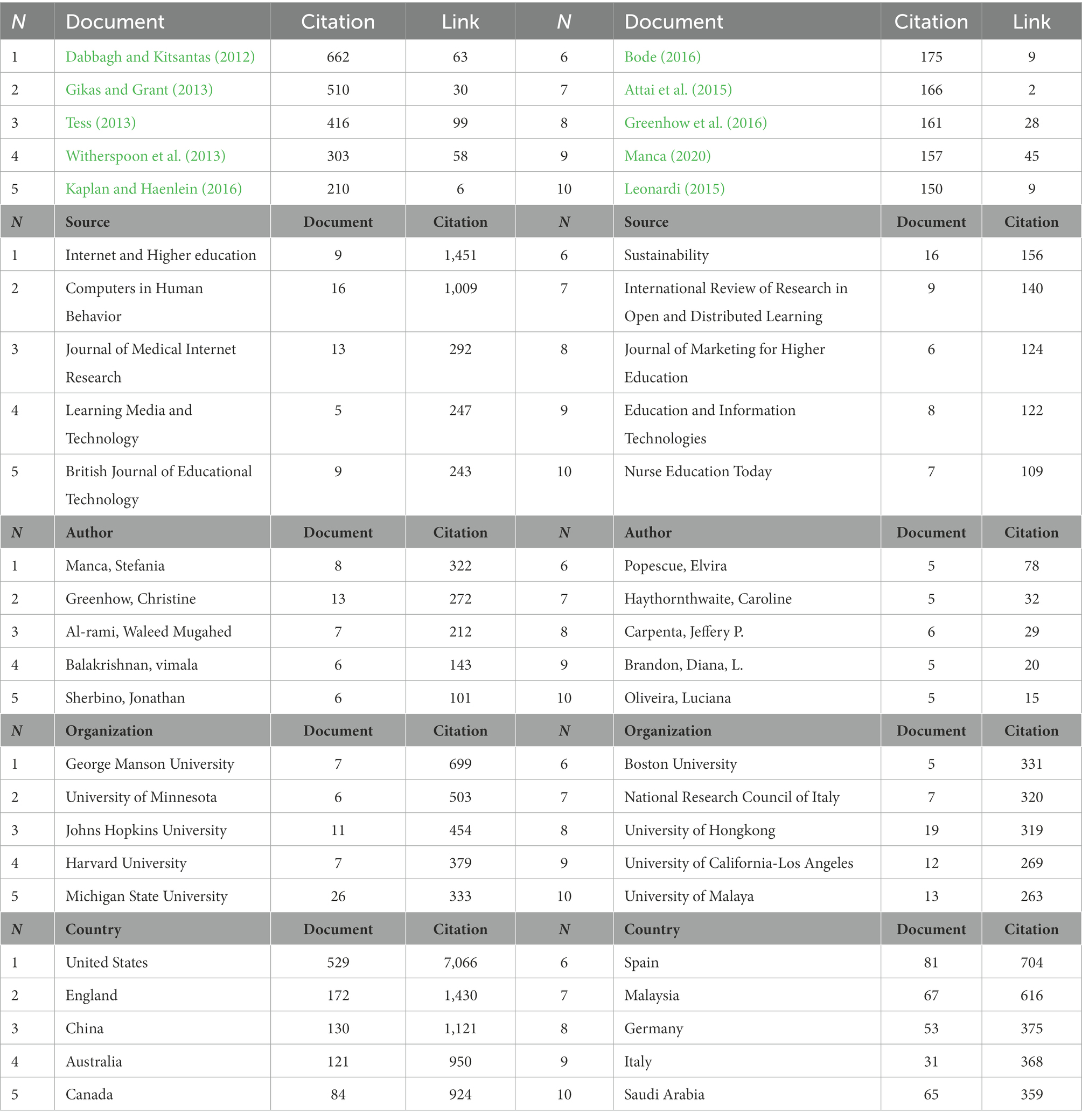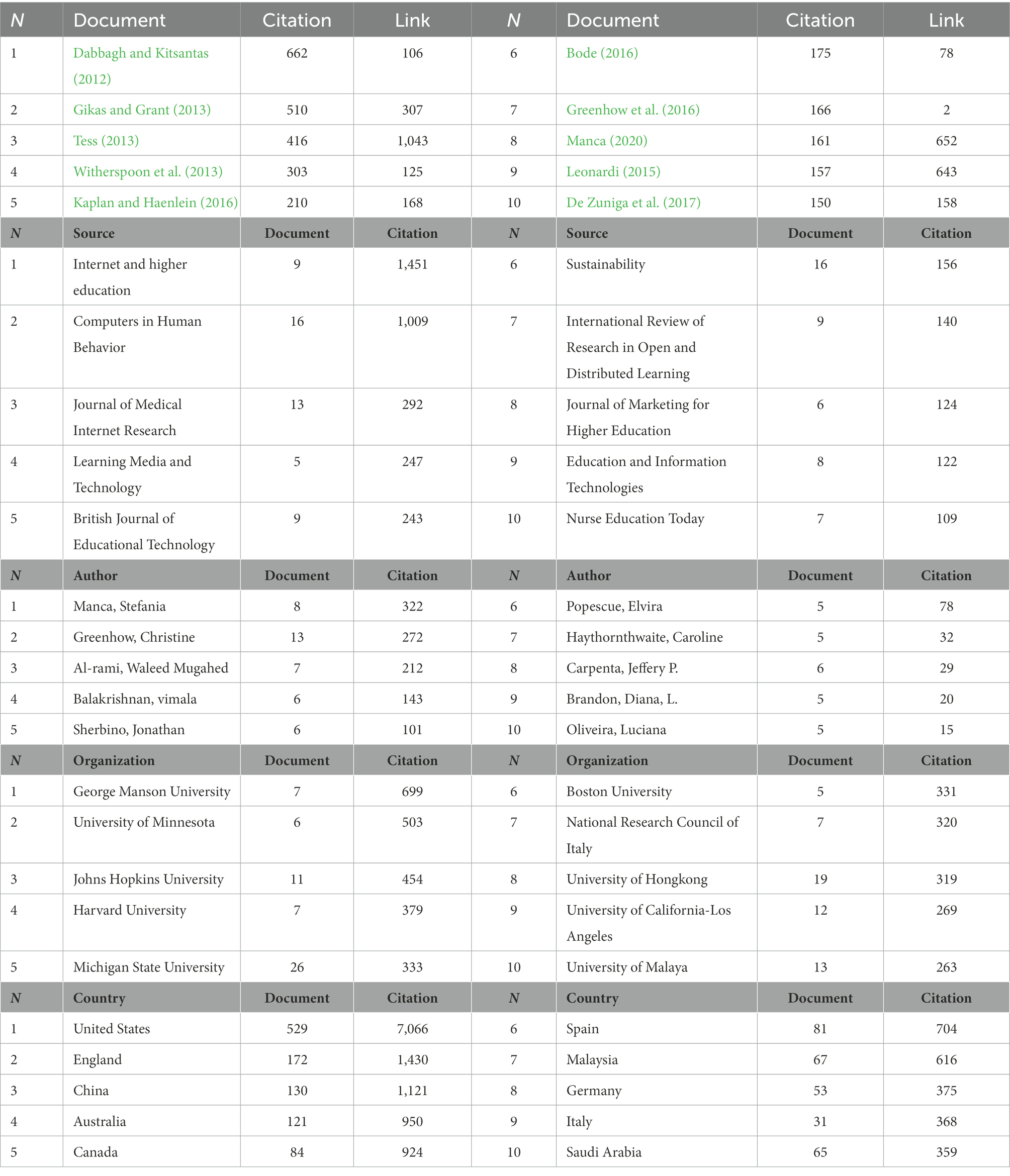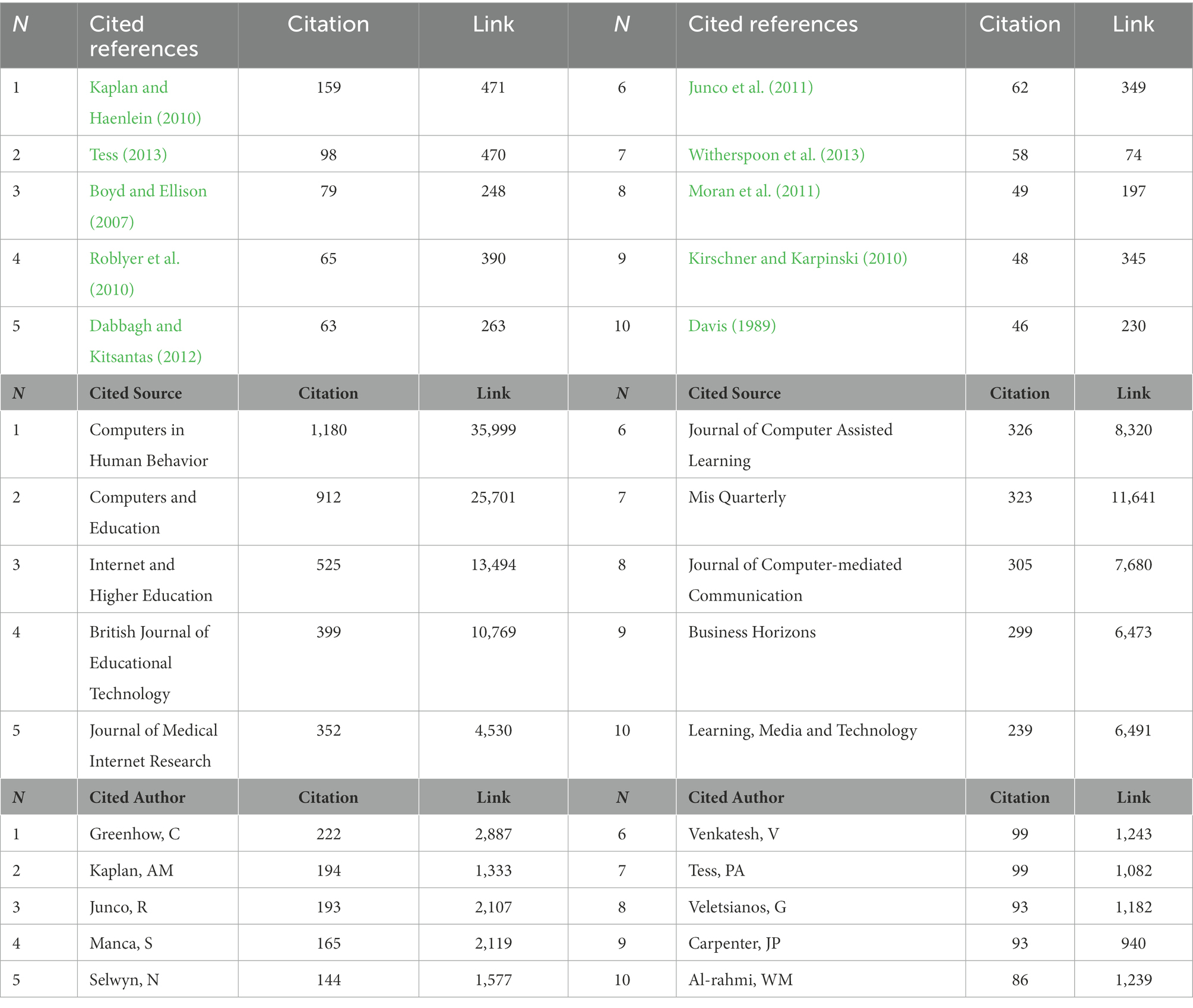- 1Department of English Studies, Faculty of Foreign Studies, Beijing Language and Culture University, Beijing, China
- 2Faculty of Liberal Arts, Mahidol University, Nakhon Pathom, Thailand
- 3Faculty of Humanities and Social Sciences, City University of Macau, Taipa, Macau SAR, China
The unexpected outbreak of COVID-19 pandemic has led students to frequently use social media to receive education, which brought about both positive and negative learning outcomes (Oliveira et al., 2022). To address the issue of integrating social media into education, this study conducted both quantitative and qualitative studies using VOSviewer and CitNetExplorer. The qualitative study through CitNetExplorer, involving 1780 publications, concluded that while social media might have gained popularity in education based on the classic theoretical framework of the zone of proximal development, there might be many challenges such as teacher resistance, data privacy, costs, and ethical and social issues. Besides, this study conducted bibliometric analyses using VOSviewer (N = 1841) to identify the top cited authors, organizations, documents, references, sources, countries, and keywords with high occurrences based on the citation networks. In the future, researchers could enhance the studies on how to guide students and teachers to properly integrate social media into education.
Introduction
The sudden outbreak of COVID-19 pandemic has led students to frequently use social media to implement distance learning, which brought about both positive and negative learning outcomes (Oliveira et al., 2022). Social media could expand the scope of social networks in users’ academic activities or their extracurricular education. However, teachers and parents were worried about the negative effects of excessive access to social media on children’s physical condition, personal information protection, and on-campus education interference (Lu, 2021). The frequent use of social media could positively influence digital reading comprehension although no positive influence was revealed on adolescent learners. The use of social media in eastern countries could not cause significant improvements in digital reading comprehension, while it could positively influence digital reading skills in western countries (Chen et al., 2021).
As shown in Figure 1, the use of social media for educational purposes has caught researchers’ attention since it was launched in the year 2009. The number of studies steadily went up until the year 2015 when the research reached a peak. After that, the number of relative studies fluctuated but with a steady growth until it arrived at the second peak in the year 2020. The year 2021 witnessed a slight decline in social media-assisted educational research possibly due to the delay in database inclusion. In general, the research into social media-assisted education has gained popularity in the recent decade. While the application of social media to education is increasingly drawing researchers’ attention with the development of information technologies, scanty studies have been devoted to the bibliometric analysis of the use of social media for the educational purpose (Barrot, 2021). This study, aiming to conduct bibliometric analyses of social media for educational purposes, seems meaningful since it attempts to complement the scanty studies by combining VOSviewer with CitNetExplorer.
Theoretical framework
Social constructivism theory has provided a theoretical foundation for the use of social media in education. Social constructivism theory assumes that social connections with peers, teachers, or friends play an important role in educational outcomes (Manca, 2020). This theory is in essence student-centered, where social interactions are deemed as a key factor that facilitates learning since students can share opinions, solve problems, and collaborate through mutual communication. The frequent social interactions assisted with social media tools could increase students’ access to knowledge and enhance their motivation to learn. The established social networks might provide a sea of learning resources where students could receive new information and insights.
Interdisciplinary collaboration is becoming increasingly important in the contemporary and future research since scientific issues are growing as systematic problems in need of collaboration of experts from various disciplines (Domik and Fischer, 2011, p. 129). Interdisciplinary experts can work collaboratively through social platforms or any learning management system to work on the same scientific issue in the real-world laboratory (Lu, 2021). Learners and teachers can also deliver and absorb knowledge through multiple platforms and close social networks based on social media or educational platforms. It is thus necessary to analyze the effects of social media on educational outcomes. Bibliometric analyses can provide solid references for the relevant research by clustering research publications and shedding light on top authors, organizations, countries, keywords, documents, the sources. This study aims to identify the effects of social media on educational outcomes through a bibliometric analysis.
Literature review
Numerous social media have been widely used in education and exerted a great influence on educational outcomes. Facebook was found able to improve learning outcomes while no gender differences were found. Twitter could also improve educational outcomes in most countries. However, it also made the distinctions unclear between education, entertainment, and social interactions (Manca, 2020), which might have negatively influenced the effectiveness of educational practice. Given previous inconsistent findings, we attempted to examine the effect of social media on educational outcomes using CitNetExplorer. We, therefore, proposed the following research question:
Can the Use of social media improve educational outcomes?
Given the important role of bibliometric analysis in the advancement of educational studies, numerous studies adopted this method to explore related areas, e.g., the use of technology (Shen and Ho, 2020), the management of education (Hallinger and Kovacevic, 2019), education of medical sciences (Azer, 2015), and linguistic science education (Barrot, 2020). Very few studies examined the use of social media in education via a meta-analysis although some studies explored the applications of social media using critically analytical (e.g., Sterling et al., 2017; Nagle, 2018; Bruguera et al., 2019) and meta-analytical methods (e.g., Marker et al., 2018). Most of these meta-analyses and critical analyses focused on the technological issue of social media platforms.
While seldom studies combined VOSviewer with CitNetExplorer to conduct bibliometric analyses, several studies analyzed the use of social media in education through bibliometric analyses or meta-analyses. Through a bibliometric analysis, Facebook was found to be widely accepted by learners in the United States, Australia, Turkey, the United Kingdom, and Taiwan and “Computers and Education” was the most influential journal to publish the research into social media for educational purposes. The studies on the use of social media in education could be integrated into other disciplines such as computing technologies, language sciences, and medical sciences (Lopes et al., 2017). WhatsApp was considered a popular social media for educational purposes while Facebook and Twitter outweighed other social media (Manca, 2020). Considering the scanty studies on the bibliometric analyses of social media for educational purposes, we tried to conduct bibliometric analyses using VOSviewer. This study proposed the second research question as follows:
What are the top authors, organizations, countries, keywords, documents, sources, and references in social media-assisted educational research?
Materials and methods
To answer the first research question, we conducted a qualitative analysis using CitNetExplorer. On November 19, 2022, we searched the Core Collection of Web of Science by entering “social media” and educat* OR learn* OR teach* as titles, leading to 2015 results. We entered the result into Endnote 20 to check and remove duplications. The specific process was click “library” and “find duplicates” in the command column. Then the program would compare and find duplicates. We then selected the records to keep. The records not selected would be moved to trash.
Two independent researchers perused the results and removed those unrelated, leading to the final 1,841 results (Figure 2). They adopted a four-step approach to making a decision. Firstly, they read the titles to determine if they were relevant to this research. They would remove them if they found them irrelevant. Otherwise, they would continue to read the abstract to determine the relevance as a second step. Thirdly, if titles and abstracts were relevant, they would read the conclusion to decide on the relevance. Fourthly, if both of them failed to reach an agreement on any decision, a third rater would be invited to make the final decision. The inter-rater reliability (k = 0.84) reached a satisfactory level. We removed the document type “early access” to avoid the system errors. The final included documents (N = 1780) included articles (N = 941), proceedings papers (N = 586), meeting abstracts (N = 121), editorial materials (N = 84), early access (N = 61), review articles (N = 60), letters (N = 34), book reviews (N = 22), news items (N = 5), and book chapters (N = 4). The classification might be overlapped and the total number might be thus not equal to the total results.
To answer the second research question, we conducted a bibliometric analysis using VOSviewer. We used the obtained results (N = 1841) without removing the “early access” documents since no systematic errors occurred (Figure 2). We implemented the bibliometric analyses via co-authorship (authors, organizations, and countries), co-occurrence (all keywords, author keywords, and keywords plus), citation (documents, sources, authors, organizations, and countries), bibliographic coupling (documents, sources, authors, organizations, and countries), and co-citation (cited references, cited sources, and cited authors).
Results
This result section aims to analyze the scattering of highly cited publications for the use of social media in educational fields based on Bradford’s law (Venable et al., 2016). It highlights the most highly cited authors, organizations, countries, keywords, documents, sources, and references, as well as the educational outcomes due to the use of social media.
Can the use of social media improve educational outcomes?
The networks constructed by CitNetExplorer consisted of 1,967 publications ranging from 1978 to 2021, and 4,929 citation links. The reason why the publications outnumber the originally retrieved literature is that the citation network includes both predecessors and successors. Predecessors refer to the publications cited by a certain number of publications in the current network, while successors indicate those citing a certain number of publications in the current network (Van Eck and Waltman, 2017). Clustering techniques in CitNetExplorer divided the citation networks into six groups by merging small clusters (Figure 3).
Table 1 presents detailed data regarding several variables, which could provide a meaningful reference for readers, researchers, and practitioners. The minimum cluster size was set at 10, and the resolution was set at 1. Some publications (N = 644) did not belong to any cluster.
We focused our exploration on the first cluster since it presented the largest number of publications, citation links, the most publications with more than 10 citations, and the top number of documents in 100 most cited publications (Table 1). We collected data from pioneering publications, four studies with top citation scores, and the most recent studies to generalize the major topics and discuss the implications (Table 2).
As shown in Table 2, much earlier, the study authored by Vygotsky (1978), with the highest citation score, paved a solid theoretical foundation for the use of social media in education. Previously, it was generally maintained that the learning process and development of human brain coincided with each other. However, Vygotsky (1978) altered it by arguing that the learning process could create the zone of proximal development and that the learning process preceded the zone of proximal development. The use of social media in learning might be able to improve the zone of proximal development by way of the enhancement of interactions between users, peers, or superiors. This process seems like the argument that “good learning” could improve the zone of proximal development via the interactions between children and adults (Vygotsky, 1978), leading to improved learning outcomes.
Social media could be conceptualized under the theoretical framework where social presence, media richness, self-presentation, and self-disclosure were involved (Kaplan and Haenlein, 2010). The theory of social presence (Short et al., 1976) indicated the aural, oral, visual, or physical contacts realized during the communication process through social media. Social presence was positively correlated with social influence. The theory of media richness (Daft and Lengel, 1986) referred to the assumption that social media might resolve ambiguity and reduce vagueness. The notion “richness” indicated the amount of information transmitted through social media which was positively related to the ability to reduce ambiguity and vagueness. The theory of social presentation meant that people desired to influence others during the social media-assisted communication. They might either wish to obtain rewards or establish their own social identities or statuses (Bin Tareaf et al., 2020), which could be realized through self-disclosure. Self-disclosure acted as an important step for communicators to establish mutually trustable interpersonal relationships.
Characterized by social presence, media richness, self-presentation, and self-disclosure, social media might improve the zone of proximal development when used in education. Social presence could increase the frequency of contacts by way of various kinds of interactions, which might be conducive to the zone of proximal development in human brains. The increasing amount of information could also help communicators resolve misunderstandings and misconceptions, which could improve learning effectiveness and facilitate the proximal development. Through self-disclosure, learners could make every effort to enhance their self-representation and influence others by enhancing their learning identities. This might enhance their self-efficacy and improve their interactions with cyber friends or learning peers, which encouraged students to adopt social media in their learning process.
Surprisingly, the study with the fourth citation score (Roblyer et al., 2010) found that students and teachers held contradictory attitudes toward social media. Social media, providing rich learning resources for learners and teachers, have been widely accepted by students in education. Students tended to be more open to innovative technologies and readier to accept them such as social media than teachers in the educational process. However, teachers were more likely to implement the teaching practice using traditional methods, e.g., email (Roblyer et al., 2010). Pharmacy majors held positive attitudes toward the use of social media in learning although they felt uneasy when confronted with teachers. Teachers, who had no enough social media-assisted teaching experience, were not accustomed to the use of social media in their teaching practice (Mawdsley, 2015). Teachers might resist changing their traditional and convenient methods since the alteration was in need of many efforts in both time and energy. Data privacy might also be a serious issue that they, as adults, were aware of.
Social media has gained popularity applied to the field of education, where data privacy has drawn much attention. Pre-service teachers, who were aware of both benefits and challenges of educational social media, held neutral attitudes toward the use of social media for educational purposes. Their attitudes toward the educational social media were not proven related to the awareness of data privacy (Marín et al., 2021). This paradoxical finding was consistent with a previous study (Obar and Oeldorf-Hirsch, 2020), which indicated that although users of social media tended to claim that they attached much importance to their privacy when using social media, they ignored this when they were requested to answer the question digitally. Similarly, educators tended to disregard the issue of data privacy when they ticked the question such as “do you agree to the term?” (Walster, 2017).
Contradictory findings were revealed regarding the concern with data privacy in the use of social media. While numerous researchers concluded that data privacy might be a serious issue users worry about, Walster (2017) revealed that educators might not be concerned with the issue of data privacy when they applied social media to education despite their strong awareness of privacy disclosure. The majority of medical learners showed their worries about their privacy disclosure when using social media (Flickinger et al., 2015). They, therefore, changed their privacy settings to prevent possible revelation of personal information (Walton et al., 2015). In addition to data privacy, some learners were worried about their poor digital literacy (O’Connor et al., 2021), which might hinder their effective use of social media in education.
The study with the second citation score proposed some problems regarding the use of social media in higher education (Tess, 2013). The infrastructure for the use of social media might be costly, which was hard to be afforded in some countries or areas. The effectiveness of social media used in higher education was still dependent since researchers had just begun to collect relevant data. Teachers, who preferred traditional teaching tools, might resist adopting social media in education. Those who accepted social media in education might hold suspicious attitudes because they believed it was merely at the beginning stage (Galan et al., 2015), so was the application of other educational technologies (Tess, 2013). While social media were becoming increasingly popular on campus, the viability of their use in education had not been comprehensively demonstrated. The social media use in education is at a testing stage at an individual rather than an institutional level.
The study with the third citation score is focused on various sites of social media (Boyd and Ellison, 2007). Various social media shared in common their maintenance of social connections. Some of them aimed to cluster users and cater to their various needs based on their different preferences such as political views, cultures, habits, economic statuses, genders, or educational levels. Social media also varied in terms of the amount of updated information, communicative platforms, opinion sharing, and mobile connectivity. The variety of social media might have caused the difficulty for students to gain easy access to each of them. Different preferences and digital literacy between students and teachers might have weakened their motivation to learn or teach assisted with social media.
However, researchers did attempt to connect social media to educational institutions, e.g., schools, colleges, universities, and libraries. Students’ perceptions were revealed about the presence of teachers in the network built by Facebook (Ellison et al., 2007), which could influence teacher-student relationships (Mazer et al., 2007). Librarians held positive attitudes toward the use of social media in a library and suggested allowing minors to have free access to social media in the library (Charnigo and Barnett-Ellis, 2007). While there might be benefits of the use of social media in education, scanty studies had been conducted on the effect of social media on educational outcomes. Bibliometric analyses were supposed to complement this regret.
What are the top authors, organizations, countries, keywords, documents, sources, and references in social media-assisted educational research?
VOSviewer could construct the citation networks, conducive to bibliometric analyses. VOSviewer, complementing the functions of CitNetExplorer, aims to construct and visualize bibliometric networks at a collective level, while CiNetExplorer attempts to cluster the publications at an individual level (Van Eck and Waltman, 2017). We analyzed the co-authorship, co-occurrence, citation, bibliographic coupling, and co-citation using VOSviewer to complement the qualitative analyses using CitNetExplorer.
We conducted the bibliometric analysis based on the obtained data (N = 1967). VOSviewer read bibliometric data files collected from Web of Science. By choosing co-authorship as the analysis type and authors, organizations, and countries as analysis units, we obtained the top 10 authors, organizations, and countries based on the citations (Table 3).
By choosing co-occurrence as the analysis type and all keywords, author keywords, and keywords plus as the analysis units respectively, we obtained the top 30 keywords according to the sequence of the number of occurrences (Table 4).
We obtained the top 10 documents, sources, authors, organizations, and countries according to the rank of citations by choosing citation as the analysis type and documents, sources, authors, organizations, and countries as analysis units (Table 5).
By choosing bibliographic coupling as the analysis type and documents, sources, authors, organizations, and countries as analysis units, we obtained the top 10 documents, sources, authors, organizations, and countries based on citations, respectively (Table 6).
By choosing co-citation as the analysis type and cited references, cited sources, and cited authors as the analysis units, we obtained the top 10 cited references, cited sources, and cited authors according to the number of citations (Table 7).
Discussion
Social media-assisted educational effectiveness might be improved under the theoretical framework of the zone of proximal development despite concerns with numerous challenges. Pre-service teachers considered social media beneficial tools to encourage students to raise questions, adopt collaborative learning, and share opinions by bridging the gap between social media and their zones of proximal development (Alghamdi and Alanazi, 2019). The socio-cultural theory supported the use of social media for educational purposes, where learners’ self-regulation, the zone of proximal development, and scaffolding education were involved (Zhang et al., 2013; Cappellini, 2016). The asynchronous and synchronous social media-assisted pedagogical approaches could provide students with comprehensive scaffolding learning resources and cultivate a harmonious learning environment, leading to slight improvements in German language proficiency (Dobberfuhl-Quinlan, 2018).
However, inconsistent findings were revealed regarding the use of social media for educational purposes. Although social media might be able to facilitate learning due to their interactive and connective features, teachers might prefer traditional pedagogies to those integrated with social media. Teachers and students might evaluate the use of social media in education differently or even contradictorily. Teachers with lower digital literacy might be resistant to the acquisition of new applications in their traditional teaching process. Teachers might worry about the affordances of digital technologies and the uncertainty of contents in social media. The use of social media could by no means guarantee successful teaching or learning (Forbes, 2017).
The use of social media in education might bring about challenges although it could improve educational outcomes. The business models of social media made it easy to reveal personal information. Challenges existed in the use of social media in education, where teachers’ online profiles might be exposed to risky virtual communities (Forbes, 2017). Personal data privacy is one of the major concerns in the use of social media for educational purposes. Knowledge about the data revelation was not available to educators and students, who might be unaware of their revelation of privacy (Marín et al., 2022). However, another study found that many students could avoid the privacy revelation by easily modulating the settings in social media (Walton et al., 2015). The paradoxical findings may highlight the importance of data privacy in the use of social media for educational purposes.
Worse, the use of social media in education could never guarantee the ethical or social commitments. Teachers or students might be indulged in entertainment rather than education on their social media due to the absence of strong awareness of educational benefits (Willems et al., 2018). The fast development of social media led to many disputes about whether they could be used in higher education. Many universities and colleges took cautious measures to deal with the challenges and benefits that might be caused by the use of social media (Au et al., 2015). Although technologies such as social media could quickly fix educational problems, this quick fix might bring about in-depth and unexpected educational issues (Selwyn, 2014), including social and ethical concerns.
The construction of the infrastructure may also pose a threat to the use of social media for educational purposes. The expenditure of construction of the costly infrastructures might have also hindered the attempt to use social media for educational purposes. Learners could suffer from the unstable Internet connection, security problems, and costly purchase of equipment, which formed barriers to voluntary use of social media in education (Wickramanayake and Jika, 2018). The frequent use of technologies such as social media could lead to an engaged lifestyle, various social or ethical responsibilities, and quick working rhythms, which could make learners shoulder heavy burdens (Weatherspoon et al., 2015). While users could have inexpensive access to various kinds of social media, the frequent access could be accumulated to high living costs and heavy working burdens.
The bibliometric analysis of the use of social media for educational purposes could provide references for researchers and practitioners. When they would like to design the applications of social media for educational purposes, they could consult the top authors, e.g., Manca Stefania, Greenhow Chirstian, Al-rami Waleed Mugahed, Balakrishnan Vimala, and Sherbino Jonathan. They could visit the highly cited organizations such as George Mason University, University of Minnesota, John Hopkins University, Harvard University, and Michigan State University. They could pay much attention to the top countries that examined the use of social media for educational purposes, e.g., the United States, England, China, Australia, and Canada. They could peruse the publications in the top journals, e.g., Internet and Higher Education, Computers in Human Behavior, Journal of Medical Internet Research, Learning Media and Technology, and British Journal of Educational Technology. Among the various social media, Facebook and Twitter were the kinds most frequently mentioned. To provide a reliable reference for future research, it is necessary to conduct bibliometric analyses to facilitate the integration of social media into education.
Conclusion
Major findings
This study conducted both quantitative and qualitative studies into the use of social media in education using VOSviewer and CitNetExplorer. The qualitative study through CitNetExplorer concluded that while social media might have gained popularity in education based on the classic theoretical framework of the zone of proximal development, there might be many challenges such as teacher resistance, data privacy, costs, and ethical and social issues. In this regard, much needs to be done to improve the effective integration of social media into education. Besides, this study conducted bibliometric analyses using VOSviewer to identify the top cited authors, organizations, documents, references, sources, countries, and keywords with high occurrences based on the citation networks. Researchers and practitioners can seek the literature according to the findings, which may facilitate their research and practice effectiveness.
Limitations
The generalizability of the findings is subject to certain limitations. This study might have missed some literature due to the limitation of library sources. Databases other than Web of Science were not included in this study, which might have caused publication bias. The citation networks that guide this study may fail to represent all the research themes in the use of social media for educational purposes. Researchers may need to include a wider scope of literature to examine the use of social media for educational purposes.
Future research directions
In the future, researchers could enhance the studies on how to guide students and teachers to properly integrate social media into education. Various kinds of social media may have puzzled users who may feel it hard to decide which social media they should choose. How to leverage the features of social media to improve learning outcomes may be meaningful for future research. The use of social media for educational purposes might not have been widely accepted by educational institutions although a growing number of students are prone to this new learning method. Future researchers can study how to encourage teachers to use social media, which may, in turn, improve the acceptance of educational institutions. Future advanced machine-learning technologies could also be integrated into social media design to power the educational construction of social networks (Lecun et al., 2015).
The pandemic has greatly increased the frequency of access to social media to share opinions, concerns, and experiences, where people could collaborate in learning to address the educational issue during the lockdown (Johnstone and Towbin, 2022). The COVID-19 pandemic requires the strategies of use of social media in medical fields to contain the pandemic (Bora et al., 1800). Future researchers could thus figure out how to improve the online, remote, or blended educational outcomes using social media, especially during the unpredictable pandemic time.
Data availability statement
The original contributions presented in the study are included in the article/supplementary material, further inquiries can be directed to the corresponding author.
Author contributions
ZY conceptualized, designed, collected, analyzed the data, wrote, edited, and polished this article. PS and WX revised, proofed, funded and edited the article. All authors contributed to the article and approved the submitted version.
Funding
This work was supported by 2019 MOOC of Beijing Language and Culture University (MOOC201902) (Important) “Introduction to Linguistics”; “Introduction to Linguistics” of online and offline mixed courses in Beijing Language and Culture University in 2020; Special fund of Beijing Co-construction Project-Research and Reform of the “Undergraduate Teaching Reform and Innovation Project” of Beijing Higher Education in 2020-Innovative “Multilingual +” Excellent Talent Training System (202010032003); The research project of Graduate Students of Beijing Language and Culture University “XJ: The Governance of China” (SJTS202108).
Conflict of interest
The author declares that the research was conducted in the absence of any commercial or financial relationships that could be construed as a potential conflict of interest.
Publisher’s note
All claims expressed in this article are solely those of the authors and do not necessarily represent those of their affiliated organizations, or those of the publisher, the editors and the reviewers. Any product that may be evaluated in this article, or claim that may be made by its manufacturer, is not guaranteed or endorsed by the publisher.
References
Alghamdi, A. K., and Alanazi, F. H. (2019). Creating scientific dialogue through social media: exploration of Saudi pre-service science teachers. Res. Sci. Technol. Educ. 37, 471–491. doi: 10.1080/02635143.2019.1570107
Attai, D. J., Cowher, M. S., Al-Hamadani, M., Schoger, J. M., Staley, A. C., and Landercasper, J. (2015). Twitter Social Media is an Effective Tool for Breast Cancer Patient Education and Support: Patient-Reported Outcomes by Survey. Journal of Medical Internet Research 17:e188. doi: 10.2196/jmir.4721
Au, M., Lam, J., and Chan, R. (2015). “Social media education: barriers and critical issues” in Technology in education: Transforming educational practices with technology. eds. K. C. Li, T. L. Wong, S. K. Cheung, J. Lam, and K. K. Ng (Berlin: Springer), 199–205. doi: 10.1007/978-3-662-46158-7_20
Azer, S. A. (2015). The top-cited articles in medical education: a bibliometric analysis. Acad. Med. 90, 1147–1161. doi: 10.1097/acm.0000000000000780
Barrot, J. S. (2020). Effects of Facebook-based e-portfolio on ESL learners’ writing performance. Lang. Cult. Curric. 34, 95–111. doi: 10.1080/07908318.2020.1745822
Barrot, J. S. (2021). Scientific mapping of social Media in Education: a decade of exponential growth. J. Educ. Comput. Res. 59, 645–668. doi: 10.1177/0735633120972010
Bin Tareaf, R., Berger, P., Hennig, P., and Meinel, C. (2020). Cross-platform personality exploration system for online social networks: Facebook vs. Twitter. Web Intellig. 18, 35–51. doi: 10.3233/WEB-200427
Bode, L. (2016). Political news in the news feed: Learning politics from social media. Mass Communication and Society 19, 24–48. doi: 10.1080/15205436.2015.1045149
Bora, K., Pagdhune, A., Patgiri, S. J., Barman, B., Das, D., and Borah, P. (1800). Does social media provide adequate health education for prevention of COVID-19? A case study of YouTube videos on social distancing and hand-washing. Health Educ. Res. 36, 398–411. doi: 10.1093/her/cyab028
Boyd, D. M., and Ellison, N. B. (2007). Social network sites: definition, history, and scholarship. J. Comput.-Mediat. Commun. 13, 210–230. doi: 10.1111/j.1083-6101.2007.00393.x
Bruguera, C., Guitert, M., and Romeu, T. (2019). Social media and professional development: a systematic review. Res. Learn. Technol. 27, 1–18. doi: 10.25304/rlt.v27.2286
Cappellini, M. (2016). Roles and scaffolding in teletandem interactions: a study of the relations between the sociocultural and the language learning dimensions in a French-Chinese teletandem. Innov. Lang. Learn. Teach. 10, 6–20. doi: 10.1080/17501229.2016.1134859
Charnigo, L., and Barnett-Ellis, P. (2007). Checking out Facebook.com: the impact of a digital trend on academic libraries. Inf. Technol. Libr. 26:23. doi: 10.6017/ital.v26i1.3286
Chen, J. P., Lin, C. H., and Chen, G. W. (2021). A cross-cultural perspective on the relationships among social media use, self-regulated learning and adolescents' digital reading literacy. Comput. Educ. 175:104322. doi: 10.1016/j.compedu.2021.104322
Dabbagh, N., and Kitsantas, A. (2012). Personal learning environments, social media, and self-regulated learning: a natural formula for connecting formal and informal learning. Internet High. Educ. 15, 3–8. doi: 10.1016/j.iheduc.2011.06.002
Daft, R. L., and Lengel, R. H. (1986). Organizational information requirements, media richness and structural design. Manag. Sci. 32, 554–571. Available at: http://links.jstor.org/sici?sici=0025-1909%28198605%2932%3A5%3C554%3AOIRMRA%3E2.0.CO%3B2-O. doi: 10.1287/mnsc.32.5.554
Davis, F. D. (1989). Perceived usefulness, perceived ease of use, and user acceptance of information technology. MIS Q. 13:319. doi: 10.2307/249008
De Zuniga, H. G., Weeks, B., and Ardevol-Abreu, A. (2017). Effects of the News-Finds-Me Perception in Communication: Social Media Use Implications for News Seeking and Learning About Politics. Journal of Computer-mediated Communication 22, 105–123. doi: 10.1111/jcc4.12185
Dobberfuhl-Quinlan, J. (2018). “Exploring sociocultural theory application in online language courses” in Learning and Collaboration Technologies: Learning and Teaching: LCT 2018: Lecture Notes in Computer Science, Vol. 10925. eds. P. Zaphiris and A. Ioannou (Cham: Springer). 265–275. doi: 10.1007/978-3-319-91152-6_21
Domik, G., and Fischer, G. (2011). “Transdisciplinary collaboration and lifelong learning: fostering and supporting new learning opportunities” in Rainbow of computer science. Vol. 6570. eds. C. S. Calude, G. Rozenberg, and A. Salomaa (Berlin, Heidelberg: Springer), 129–143. doi: 10.1007/978-3-642-19391-0_10
Ellison, N. B., Steinfield, C., and Lampe, C. (2007). The benefits of Facebook “friends:” social capital and college students’ use of online social network sites. J. Comput.-Mediat. Commun. 12, 1143–1168. doi: 10.1111/j.1083-6101.2007.00367.x
Flickinger, T. E., O’Hagan, T., and Chisolm, M. S. (2015). Developing a curriculum to promote professionalism for medical students using social media: pilot of a workshop and blog-based intervention. JMIR Med. Educ. 1:e17. doi: 10.2196/mededu.4886
Forbes, D. (2017). Professional online presence and learning networks: educating for ethical use of social media. Int. Rev. Res. Open Distrib. Learn. 18, 175–190. doi: 10.19173/irrodl.v18i7.2826
Galan, M., Lawley, M., and Clements, M. (2015). Social media's use in postgraduate students' decision-making journey: an exploratory study. J. Mark. High. Educ. 25, 287–312. doi: 10.1080/08841241.2015.1083512
Gikas, J., and Grant, M. M. (2013). Mobile Computing Devices in Higher Education: Student Perspectives on Learning with Cellphones, Smartphones and Social Media. The Internet and Higher Education 19, 18–26. doi: 10.1016/j.iheduc.2013.06.002
Greenhow, C., Sonnevend, J., and Agur, C. (2016). Education and social media: Toward a digital future. Cambridge, MA: The MIT Press, Digital Media and Learning Series.
Hallinger, P., and Kovacevic, J. (2019). A bibliometric review of research on educational administration: science mapping the literature, 1960 to 2018. Rev. Educ. Res. 89, 335–369. doi: 10.3102/0034654319830380
Johnstone, L. A. G. S., and Towbin, A. J. (2022). The use of social media in radiology education. Acad. Radiol. 29, 84–86. doi: 10.1016/j.acra.2021.05.010
Junco, R., Heiberger, G., and Loken, E. (2011). The effect of twitter on college student engagement and grades. J. Comput. Assist. Learn. 27, 119–132. doi: 10.1111/j.1365-2729.2010.00387.x
Kaplan, A. M., and Haenlein, M. (2016). Higher Education and the Digital Revolution: About MOOCs, SPOCs, Social Media, and the Cookie Monster. Business Horizons 59, 441–450. doi: 10.1016/j.bushor.2016.03.008
Kaplan, A. M., and Haenlein, M. (2010). Users of the world, unite! The challenges and opportunities of social media. Bus. Horiz. 53, 59–68. doi: 10.1016/j.bushor.2009.09.003
Kirschner, P. A., and Karpinski, A. C. (2010). Facebook® and academic performance. Comput. Hum. Behav. 26, 1237–1245. doi: 10.1016/j.chb.2010.03.024
Lecun, Y., Bengio, Y., and Hinton, G. (2015). Deep learning. Nature 521, 436–444. doi: 10.1038/nature14539
Leonardi, P. M. (2015). Ambient Awareness and Knowledge Acquisition: Using Social Media to Learn “Who Knows What” and “Who Knows Whom”. MIS Quarterly 39, 747–762. doi: 10.25300/MISQ/2015/39.4.1
Lopes, R. M., Faria, D. J., Fidalgo-Neto, A. A., and Mota, F. B. (2017). Facebook in educational research: a bibliometric analysis. Scientometrics 111, 1591–1621. doi: 10.1007/s11192-017-2294-1
Lu, J. (2021). Exploring the adoption of social media in self-paced physical activity in early childhood education: a case in Central China. Educ. Technol. Res. Dev. 70, 321–338. doi: 10.1007/s11423-021-10059-8
Manca, S. (2020). Snapping, pinning, liking or texting: investigating social media in higher education beyond Facebook. Internet High. Educ. 44:100707. doi: 10.1016/j.iheduc.2019.100707
Marín, V. I., Carpenter, J. P., and Tur, G. (2021). Pre-service teachers’ perceptions of social media data privacy policies. Br. J. Educ. Technol. 52, 519–535. doi: 10.1111/bjet.13035
Marín, V. I., Carpenter, J. P., Tur, G., and Williamson-Leadley, S. (2022). Social media and data privacy in education: an international comparative study of perceptions among pre-service teachers. J. Comp. Educ. doi: 10.1007/s40692-022-00243-x
Marker, C., Gnambs, T., and Appel, M. (2018). Active on Facebook and failing at school? Meta-analytic findings on the relationship between online social networking activities and academic achievement. Educ. Psychol. Rev. 30, 651–677. doi: 10.1007/s10648-017-9430-6
Mawdsley, A. (2015). Pharmacy students' perceptions of social media in education. Pharm. Educ. 15, 108–110. https://pharmacyeducation.fip.org/pharmacyeducation/article/view/346
Mazer, J. P., Murphy, R. E., and Simonds, C. J. (2007). I'll see you on “Facebook”: the effects of computer-mediated teacher self-disclosure on student motivation, affective learning, and classroom climate. Commun. Educ. 56, 1–17. doi: 10.1080/03634520601009710
Moran, M., Seaman, J., and Tinti-Kane, H. (2011). Teaching, learning, and sharing: How Today's higher education faculty use social media. Boston, MA: © 2011 Pearson learning solutions and Babson survey research group Pearson learning solutions. Available at: https://files.eric.ed.gov/fulltext/ED535130.pdf
Nagle, J. (2018). Twitter, cyber-violence, and the need for a critical social media literacy in teacher education: a review of the literature. Teach. Teach. Educ. 76, 86–94. doi: 10.1016/j.tate.2018.08.014
O’Connor, S., Zhang, M. Y., Honey, M., and Lee, J. J. (2021). Digital professionalism on social media: a narrative review of the medical, nursing, and allied health education literature. Int. J. Med. Inform. 153:104514. doi: 10.1016/j.ijmedinf.2021.104514
Obar, J. A., and Oeldorf-Hirsch, A. (2020). The biggest lie on the internet: ignoring the privacy policies and terms of service policies of social networking services. Inf. Commun. Soc. 23, 128–147. doi: 10.1080/1369118X.2018.1486870
Oliveira, L., Silva, P., Mesquita, A., Sequeira, A. S., and Oliveira, A. (2022). Sadness, negativity, and uncertainty in education during COVID-19 on social media. Int. J. Online Pedagog. Course Des. 12, 1–21. doi: 10.4018/IJOPCD.2022010103
Roblyer, M. D., Mcdaniel, M., Webb, M., Herman, J., and Witty, J. V. (2010). Findings on Facebook in higher education: a comparison of college faculty and student uses and perceptions of social networking sites. Internet High. Educ. 13, 134–140. doi: 10.1016/j.iheduc.2010.03.002
Selwyn, N. (2014). Digital technology and the contemporary university: Degrees of digitization. 1st edn. New York, NY: Routledge, doi: 10.4324/9781315768656.
Shen, C. W., and Ho, J. T. (2020). Technology-enhanced learning in higher education: a bibliometric analysis with latent semantic approach. Comput. Hum. Behav. 104:106177. doi: 10.1016/j.chb.2019.106177
Short, J., Williams, E., and Christie, B. (1976). The social psychology of telecommunications. Hoboken, NJ: John Wiley and Sons Ltd. doi: 10.1016/0308-5961(77)90016-7
Sterling, M., Leung, P., Wright, D., and Bishop, T. F. (2017). The use of social media in graduate medical education: a systematic review. Acad. Med. J. Assoc. Am. Med. Coll. 92, 1043–1056. doi: 10.1097/ACM.0000000000001617
Tess, P. A. (2013). The role of social media in higher education classes (real and virtual) – a literature review. Comput. Hum. Behav. 29, A60–A68. doi: 10.1016/j.chb.2012.12.032
Van Eck, N. J., and Waltman, L. (2017). Citation-based clustering of publications using CitNetExplorer and VOSviewer. Scientometrics 111, 1053–1070. doi: 10.1007/s11192-017-2300-7
Venable, G. T., Shepherd, B. A., Loftis, C. M., McClatchy, S. G., Roberts, M. L., Fillinger, M. E., et al. (2016). Bradford's law: identification of the core journals for neurosurgery and its subspecialties. J. Neurosurg. 124, 569–579. doi: 10.3171/2015.3.JNS15149
Vygotsky, L.S. (1978). Mind in society: Development of higher psychological processes. United States: Harvard University Press. doi: 10.2307/j.ctvjf9vz4
Walster, D. (2017). Information policy and social media: accept or decline. Tech Trends 61, 301–307. doi: 10.1007/s11528-017-0179-z
Walton, J. M., White, J., and Ross, S. (2015). What’s on YOUR Facebook profile? Evaluation of an educational intervention to promote appropriate use of privacy settings by medical students on social networking sites. Med. Educ. Online 20:28708. doi: 10.3402/meo.v20.28708
Weatherspoon, D., Weatherspoon, C., and Ristau, C. (2015). Speaking their language: integrating social media into childbirth education practice. Int. J. Childbirth Educ. 30, 21–24.
Wickramanayake, L., and Jika, S. M. (2018). Social media use by undergraduate students of education in Nigeria: a survey. Electron. Libr. 36, 21–37. doi: 10.1108/EL-01-2017-0023
Willems, J., Adachi, C., Bussey, F., Doherty, I., and Huijser, H. (2018). Debating the use of social media in higher education in Australasia: where are we now? Australas. J. Educ. Technol. 34:843. doi: 10.14742/ajet.3843
Witherspoon, C. L., Bergner, J., Cockrell, C., and Stone, D. N. (2013). Antecedents of organizational knowledge sharing: a meta-analysis and critique. Journal of Knowledge Management 17, 250–277. doi: 10.1108/13673271311315204
Keywords: bibliometric analysis, social media, education, educational outcomes, challenges
Citation: Yu Z, Sukjairungwattana P and Xu W (2023) Bibliometric analyses of social media for educational purposes over four decades. Front. Psychol. 13:1061989. doi: 10.3389/fpsyg.2022.1061989
Edited by:
Cheng Yong Tan, The University of Hong Kong, Hong KongSAR, ChinaReviewed by:
Diana Marin-Suelves, University of Valencia, SpainAntonio Luque, University of Almeria, Spain
Maxime Descartes Mbogning Fonkou, Institut Gustave Roussy, France
Copyright © 2023 Yu, Sukjairungwattana and Xu. This is an open-access article distributed under the terms of the Creative Commons Attribution License (CC BY). The use, distribution or reproduction in other forums is permitted, provided the original author(s) and the copyright owner(s) are credited and that the original publication in this journal is cited, in accordance with accepted academic practice. No use, distribution or reproduction is permitted which does not comply with these terms.
*Correspondence: Zhonggen Yu,  MTg5NTE4MDE4ODBAMTg5LmNu; NDAxMzczNzQyQHFxLmNvbQ==; Paisan Sukjairungwattana,
MTg5NTE4MDE4ODBAMTg5LmNu; NDAxMzczNzQyQHFxLmNvbQ==; Paisan Sukjairungwattana,  cGFpc2FuLnN1a0BtYWhpZG9sLmVkdQ==; Wei Xu,
cGFpc2FuLnN1a0BtYWhpZG9sLmVkdQ==; Wei Xu,  d2VpeHVAY2l0eXUubW8=
d2VpeHVAY2l0eXUubW8=
†ORCID: Zhonggen Yu, https://orcid.org/0000-0002-3873-980X
Paisan Sukjairungwattana, https://orcid.org/0000-0002-7568-9784
Wei Xu, https://orcid.org/0000-0002-7224-1116
 Zhonggen Yu
Zhonggen Yu Paisan Sukjairungwattana
Paisan Sukjairungwattana Wei Xu
Wei Xu